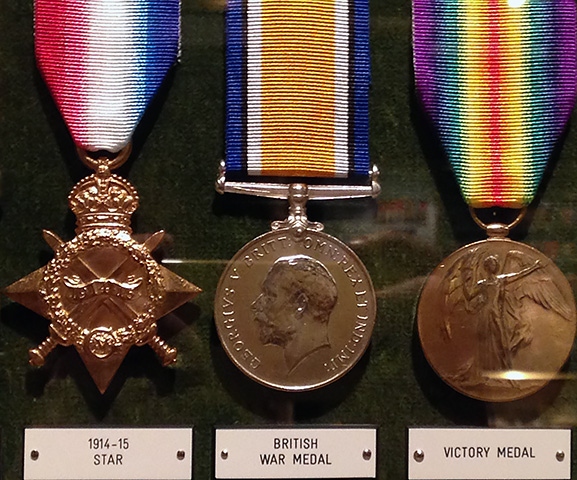Gallipoli remembered
Date published: 27 April 2015

The medals of William Buckley
By Cadet Ellie Down, Rochdale Detachment, 1 (Minden) Company GMACF.
My detachment wears the cap-badge and hackle of the Royal Regiment of Fusiliers, along with other detachment of 1 (Minden) Company. Over the weekend, 25-26 April, we commemorated the Gallipoli Landings, in which, on the first day, the Lancashire Fusiliers famously won 'six VCs before breakfast'.
As we approached the centenary of those landings, I researched a young man who served and died during this battle.
William Buckley was my great, great uncle. He was the uncle of my maternal granddad (Frank Dale) who I described in my earlier articler 'Four Generations':
http://rochdaleonline.co.uk/news-features/2/news-headlines/92758/four-generations-by-cadet-ellie-down-%E2%80%93-rochdale-detachment-1-minden-company-gmacf
William lived with his parents, William Senior and Jane Buckley along with three siblings, Amy, May and his brother Richard at 4 Stanley Road, Chadderton, Oldham.
In 1911 they moved to 166 Block Lane, Chadderton. His father worked as a textile machinist and William Jnr worked as a “piecer” at United Mill, which was on the same street as his father’s work place. Sadly his mother Jane passed away sometime between April 1911 and 1914 (the exact date is unknown). William Snr re-married between July and September 1914 to Mary Drinkwater. Mary had a son named George and she and William went on to have another child named Mary Buckley.
Meanwhile, during 1914, William had joined the 10th Battalion, the Manchester Regiment as a volunteer. A Battalion is a military unit of several companies and is commanded by a Lieutenant Colonel. On a visit to the Manchester Regiment Museum, I was informed that to be able to join the army at the start of the First World War, you had to be a minimum height of 5’3”.
Following the outbreak of war in August 1914, William was mobilised with his unit in Oldham. He served as a Private Soldier and his service number was 2224. The Battalion left to go overseas to Egypt in September 1914, however it is unclear if William went with them in that first draft, or if he joined them later on.
At about this time, William sent a postcard to his little sister, Amy (my great grandma), which read:
Dear Sister,
Just a line to let you know I am having a good time thousands of miles away across the sea. I hope this finds you in the best of health and keep (being) a good girl and obey your mother.
With love,
From your loving brother,
Willie
xxxxxxxx
William landed with his Battalion in Gallipoli on 15 May 1915. In the next two weeks he will have witnessed front-line combat against the Turks in the trenches. However, even though the Battalion did not join in with any major attacks during this time, the soldiers were still vulnerable to the Turkish artillery and snipers. This led to many casualties being suffered, one of whom William was sadly one, though we don’t know the exact circumstances of his death.
He was killed in action on the 1 June 1915. He was 19 years old.
A year after the battle of Gallipoli the government wanted to acknowledge the fallen of the Great War. The next of kin were awarded a memorial plaque, designed by Edward Carter Preston in 1918, darkly nicknamed ‘the dead man’s penny’ or the ‘death plaque’. A total of 1,355,000 plaques were issued, of which only 600 were issued to women.
These plaques bear the wording ‘he/she died for freedom and honour’. Together with a certificate, they were dispatched from Buckingham Palace. They continued to be issued into the 1930s to recognise the fallen from the battle of Gallipoli.
In 2002 William’s plaque was donated to the museum of the Manchester Regiment, as well as his Victory Medal, his 1914-15 Star and the British War Medal for his service. After the battle and the Allied evacuation of the Gallipoli Peninsula, William’s grave could not be identified, so he is one of the 20,885 men commemorated on the Helles Memorial in Turkey (between panel 158 and 170).
After the Great War, The Manchester Regiment was reduced to two Regular Army Battalions, two Militia Battalions and six Volunteer Battalions. Each Regiment in the British Army had by that time a fixed Regimental Garrison and Ashton-under-Lyne became home of the Manchester Regiment. It is here, in the modern museum to the Manchester’s that William’s medals and those of many of his regimental comrades can be found.
The Museum of the Manchester Regiment is located at Ashton Town Hall.
Do you have a story for us?
Let us know by emailing news@rochdaleonline.co.uk
All contact will be treated in confidence.
Most Viewed News Stories
- 1Royton haulage firm fined after Rochdale dad went to work and didn’t come home
- 2Six men arrested in Rochdale child exploitation investigation
- 3Suspended council candidate was ‘politically naive’ for appearing in George Galloway video, leader...
- 4Rochdale church to host Camerados public living room
- 530 years of the GEM Appeal, a Rochdale-founded charity that has raised millions and changed the...
To contact the Rochdale Online news desk, email news@rochdaleonline.co.uk or visit our news submission page.
To get the latest news on your desktop or mobile, follow Rochdale Online on Twitter and Facebook.


